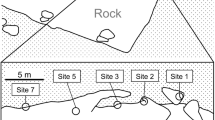Abstract
The pulmonate limpet Siphonaria gigas, a simultaneous hermaphrodite, lives in the mid- to upper-intertidal zone on rocky shores in the tropical Eastern Pacific. Samples along five transects taken in June–July, 2004, on Culebra Point (8º54′N to 79º31′W), Republic of Panama, showed that 71 % of the population occurred in fissures, a significant preference for this habitat. Of 200 adults in 27 fissures, 150 lived side by side in pairs with their shells touching or nearly so, a significant deviation from the number of pairs expected given a random arrangement. Pair frequency did not increase with limpet density suggesting pairing was not an incidental consequence of crowding. Pair living was unknown in the genus Siphonaria, and is very uncommon among simultaneous hermaphrodites. Reproductive synchrony and restrictions on movement due to predation and environmental stress may limit opportunities for encountering and mating with multiple partners favoring pair living in S. gigas.





Similar content being viewed by others
References
Angeloni L, Bradbury JW, Charnov EL (2002) Body size and sex allocation in simultaneously hermaphroditic animals. Behav Ecol 13:419–426
Baeza J (2010) The symbiotic lifestyle and its evolutionary consequences: social monogamy and ex allocation in the hermaphroditic shrimp Lysmata pederseni. Naturwissenschaften 97:729–741
Berry AJ (1977) Gastropoda: pulmonata. In: Giese AC, Pearse JS (eds) Reproduction of marine invertebrates. Academic Press, New York, pp 181–226
Bertness MD, Callaway R (1994) Positive interactions in communities. Trends Ecol Evol 9:191–193
Branch GM (1985) Limpets: evolution and adaptation. In: Clarke MR, Trueman R (eds) The mollusca. Academic Press, New York, pp 187–220
Burke RD (1986) Pheromones and the gregarious settlement of marine invertebrate larvae. Bull Mar Sci 39:323–331
Charnov EL (1982) The theory of sex allocation. Princeton University Press
Collin R (1995) Sex, size and position: a test of models predicting size at sex change in the protandrous gastropod Crepidula fornicata. Am Nat 146:815–833
Connell JH (1975) Some mechanisms producing structure in natural communities: a model and evidence from field experiments. In: Cody ML, Diamond JM (eds) Ecology and evolution of communities. Belknap Press, Cambridge, pp 460–490
Denadai MR, Amaral ACZ, Turra A (2000) Annual variation of the malacofauna on two intertidal sandy substrates with rock fragments in southeastern Brazil. Braz J Oceanogr 48:141–150
Denny M, Wethey D (2001) Physical processes that generate patterns in marine communities. In: Bertness MD, Gaines SD, Hay ME (eds) Marine community ecology. Sinauer Associates, Sunderland, pp 3–37
Emlen S, Oring L (1977) Ecology, sexual selection, and the evolution of mating systems. Science 197:215–223
Garrity SD (1984) Some adaptations of gastropods to physical stress on a tropical rocky shore. Ecology 65:559–574
Garrity SD, Levings SC (1983) Homing to scars as a defense against predators in the pulmonate limpet Siphonaria gigas (Gastropoda). Mar Biol 72:319–324
Gray DR, Hodgson AN (2004) The importance of a crevice environment to the limpet Helcion pectunculus (Patellidae). J Moll Stud 70:67–72
Hodgson AN (1999) The biology of siphonariid limpets (Gastropoda: Pulmonata). Oceanogr Mar Biol Annu Rev 37:245–314
Keen AM (1971) Sea shells of tropical west America: marine mollusks from Baja California to Peru. Stanford University Press, California
Levings SC, Garrity SD (1984) Grazing patterns in Siphonaria gigas (Mollusca, Pulmonata) on the rocky Pacific coast of Panama. Oecologia 64:152–159
Levings SC, Garrity SD (1986) Notes on reproduction of a tropical pulmonate limpet, Siphonaria gigas (Sowerby). Veliger 29:86–90
Lowell RB (1987) Safety factors of tropical versus temperate limpet shells: multiple selection pressures on a single structure. Evolution 41:638–650
Marshall DJ, McQuaid CD (1992) Comparative aerial metabolism and water relations of the intertidal limpets Patella granularis L. (Mollusca: prosobranchia) and Siphonaria oculus Kr. (Mollusca: Pulmonata). Physiol Zool 65:1040–1056
McQuaid CD, Branch GM (1984) The influence of sea temperature, substratum and wave exposure on rocky intertidal communities: an analysis of faunal and floral biomass. Mar Ecol Prog Ser 19:145–151
Menge BA, Sutherland JP (1987) Community regulation: variation in disturbance, competition, and predation in relation to environmental stress and recruitment. Am Nat 130:730–757
Pal P, Erlandsson J, Sköld M (2006) Size-assortative mating and non-reciprocal copulation in a hermaphroditic intertidal limpet: test of the mate availability hypothesis. Mar Biol 148:1273–1282
Palmer AR (1979) Fish predation and the evolution of gastropod shells sculpture: experimental and geographic evidence. Evolution 33:697–713
Petersen CW (2006) Sexual selection and reproductive success in hermaphroditic seabasses. Integr Comp Biol 46:439–448
Shanks AL (2001) Previous agnostic experience determines both foraging behavior and territoriality in the limpet Lottia gigantea (Sowerby). Behav Ecol 13:467–471
Sogabe A, Matsumoto K, Yanagisawa Y (2007) Mate change reduces the reproductive rate of males in a monogamous pipefish Corythoichthys haematopterus: the benefit of long-term pair bonding. Ethology 113:764–771
Tomanek L, Helmuth B (2002) Physiological ecology of rocky intertidal organisms: a synergy of concepts. Integr Comp Biol 42:771–775
Turra A, Denadai MR (2006) Microhabitat use by two rocky shore gastropods in an intertidal sandy substrate with rocky fragments. Braz J Biol 66:351–355
Underwood AJ (1980) The effects of grazing by gastropods and physical factors on the upper limits of distribution of intertidal macroalgae. Oecologia 46:201–213
Underwood AJ, Chapman MG (1996) Scales of spatial patterns of distribution of intertidal invertebrates. Oecologia 107:212–224
Wong J, Michiels N (2011) Control of social monogamy through aggression in a hermaphroditic shrimp. Front Zool 8:30–37
Acknowledgments
Our gratitude goes to Malina Lopez and Pedro Zevallos for their kind hospitality, to Rebecca Rissanen for assistance in the field, and to The Culebra Nature Center staff for their cooperation and support. This work was supported by a short-term Fellowship at the Smithsonian Tropical Research Institute awarded to R. C. Lombardo.
Author information
Authors and Affiliations
Corresponding author
Additional information
Communicated by J. P. Grassle.
Rights and permissions
About this article
Cite this article
Lombardo, R.C., Christy, J.H. & Cipriani, R. The false limpet Siphonaria gigas, a simultaneous hermaphrodite, lives in pairs in rock fissures on the Pacific coast of Panama. Mar Biol 160, 729–735 (2013). https://doi.org/10.1007/s00227-012-2127-y
Received:
Accepted:
Published:
Issue Date:
DOI: https://doi.org/10.1007/s00227-012-2127-y




